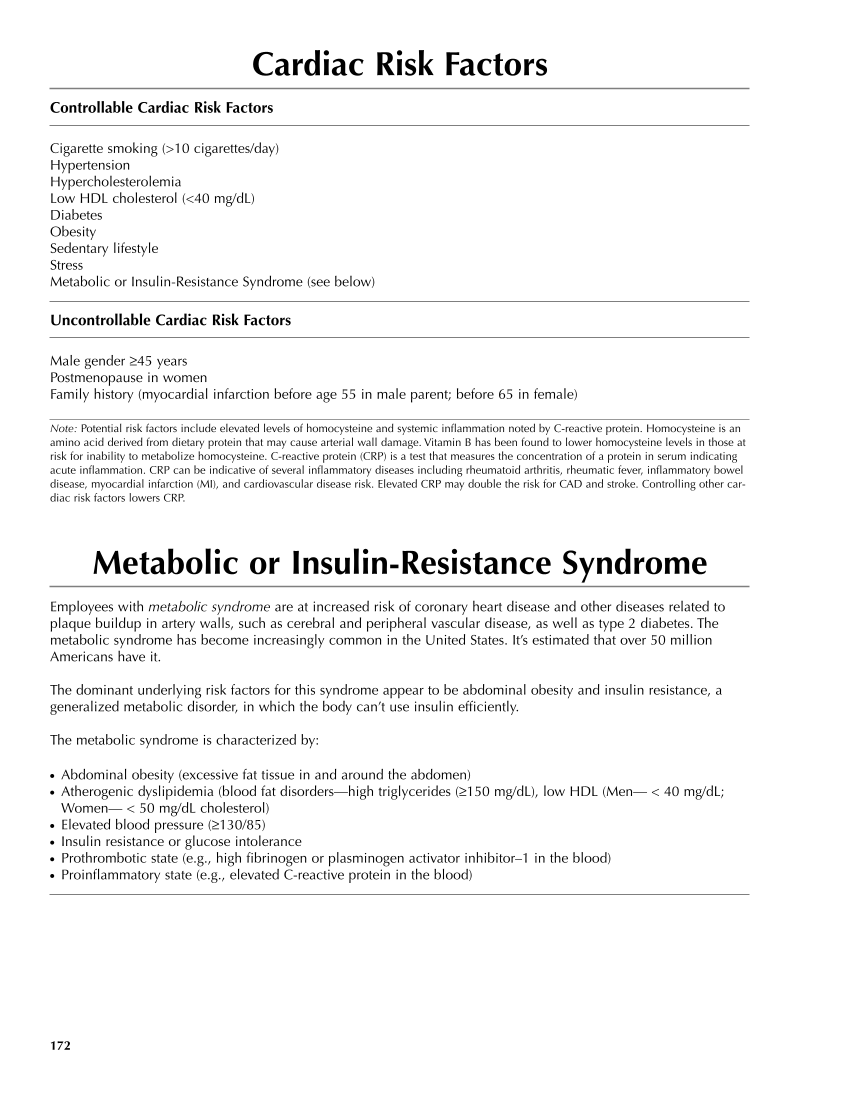172 Cardiac Risk Factors Controllable Cardiac Risk Factors Cigarette smoking (10 cigarettes/day) Hypertension Hypercholesterolemia Low HDL cholesterol (40 mg/dL) Diabetes Obesity Sedentary lifestyle Stress Metabolic or Insulin-Resistance Syndrome (see below) Uncontrollable Cardiac Risk Factors Male gender ≥45 years Postmenopause in women Family history (myocardial infarction before age 55 in male parent before 65 in female) Note: Potential risk factors include elevated levels of homocysteine and systemic inflammation noted by C-reactive protein. Homocysteine is an amino acid derived from dietary protein that may cause arterial wall damage. Vitamin B has been found to lower homocysteine levels in those at risk for inability to metabolize homocysteine. C-reactive protein (CRP) is a test that measures the concentration of a protein in serum indicating acute inflammation. CRP can be indicative of several inflammatory diseases including rheumatoid arthritis, rheumatic fever, inflammatory bowel disease, myocardial infarction (MI), and cardiovascular disease risk. Elevated CRP may double the risk for CAD and stroke. Controlling other car- diac risk factors lowers CRP. Metabolic or Insulin-Resistance Syndrome Employees with metabolic syndrome are at increased risk of coronary heart disease and other diseases related to plaque buildup in artery walls, such as cerebral and peripheral vascular disease, as well as type 2 diabetes. The metabolic syndrome has become increasingly common in the United States. It’s estimated that over 50 million Americans have it. The dominant underlying risk factors for this syndrome appear to be abdominal obesity and insulin resistance, a generalized metabolic disorder, in which the body can’t use insulin efficiently. The metabolic syndrome is characterized by: ● Abdominal obesity (excessive fat tissue in and around the abdomen) ● Atherogenic dyslipidemia (blood fat disorders—high triglycerides (≥150 mg/dL), low HDL (Men— 40 mg/dL Women— 50 mg/dL cholesterol) ● Elevated blood pressure (≥130/85) ● Insulin resistance or glucose intolerance ● Prothrombotic state (e.g., high fibrinogen or plasminogen activator inhibitor–1 in the blood) ● Proinflammatory state (e.g., elevated C-reactive protein in the blood)
Purchased from OEM Press by (ge corporate access). (C) 2013 OEM Health Information, Inc. All rights reserved.












































































































































































































































































































































































































































